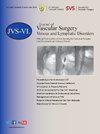Venous bypass using the internal jugular vein as the outflow tract for treating central venous stenosis and cephalic arch stenosis in hemodialysis access
IF 2.8
2区 医学
Q2 PERIPHERAL VASCULAR DISEASE
Journal of vascular surgery. Venous and lymphatic disorders
Pub Date : 2025-06-18
DOI:10.1016/j.jvsv.2025.102280
引用次数: 0
Abstract
Objective
Central venous stenosis (CVS) and cephalic arch stenosis (CAS) remain significant issues in the long-term management of hemodialysis access. Surgical bypass serves as a crucial option for symptom relief and access preservation when endovascular treatments fail. This study aimed to evaluate the effectiveness and safety of using the internal jugular vein (IJV) as the outflow tract in bypass surgery for CVS and CAS.
Methods
From December 2021 to September 2024, 21 patients undergoing hemodialysis who developed CVS (n = 15) or CAS (n = 6), were undertaken. Extra-anatomic venous bypass using the IJV were performed. Before surgical bypass, all patients had computed tomography angiography (CTA) and bilateral venograms of the upper central venous system. Color Doppler ultrasound was used to measure flow volume. A literature review was conducted to analyze the outcomes of previous studies that using venous bypass for the treatment of CVS in patients with upper extremity hemodialysis access.
Results
Technical success was achieved in all cases. Fifteen cases presented with CVS (11 men and 4 women, with a mean age of 56 ± 11 years [range, 37-82 years]) were treated by six surgical approaches include cephalic vein to contralateral-IJV bypass (n = 3), axillary vein to contralateral-IJV bypass (n = 5), external jugular vein to contralateral-IJV bypass (n = 2), IJV to contralateral-IJV bypass (n = 2), axillary vein to ipsilateral-IJV bypass (n = 1), cephalic vein to ipsilateral-IJV bypass (n = 1), and arteriovenous graft to ipsilateral-IJV bypass (n = 1). The median follow-up was 22 months (interquartile range, 12-24 months). The primary patency rate and secondary patency were 79% and 79% at 1 year and 65% and 79% at 2 years. Six patients presented with CAS (2 men and 4 women, with a mean age of 51 ± 9 years [range, 38 to 59 years]) and were treated by cephalic vein to ipsilateral-IJV bypass (n = 6). The median follow-up was 22 months (interquartile range, 15-26 months). The primary patency rate and secondary patency were 100% and 100% at 1 year and 60% and 60% at 2 years. All patients showed significant symptom improvement postoperation, with no perioperative mortality.
Conclusions
Extra-anatomic venous bypass using the IJV as outflow tract is an effective and safe alternative, providing good graft patency and low postoperative complications during midterm follow-up. Careful selection of inflow and outflow tracts is crucial for optimal outcomes.
以颈内静脉为流出道的静脉旁路治疗血液透析通路中中心静脉狭窄和头弓狭窄。
目的:中心静脉狭窄(CVS)和头弓狭窄(CAS)仍然是血液透析通路长期管理的重要问题。当血管内治疗失败时,旁路手术是缓解症状和保留通道的关键选择。本研究旨在评价颈内静脉(IJV)作为体外流出道在CVS和CAS旁路手术中的有效性和安全性。方法:从2021年12月至2024年9月,对21例发生CVS (n=15)或CAS (n=6)的血液透析患者进行研究。采用IJV进行解剖外静脉旁路。手术前,所有患者均行计算机断层血管造影(CTA)和双侧上中心静脉系统静脉造影。彩色多普勒超声测量血流容量。我们回顾文献,分析以往研究中使用静脉旁路治疗上肢血液透析通路患者CVS的结果。结果:所有病例均取得技术成功。15例出现CVS(11男性和4女性平均年龄为56±11年,37到82年)是由六个外科治疗方法包括contralateral-IJV头静脉旁路(n = 3),腋静脉侧-IJV绕过(n = 5),颈外静脉侧-IJV绕过(n = 2), IJV侧-IJV绕过(n = 2),腋静脉ipsilateral-IJV绕过(n = 1),头静脉ipsilateral-IJV绕过(n = 1),和AVG侧-IJV旁路(n = 1)。中位随访时间为22个月(IQR, 12 ~ 24个月)。一期通畅率和二期通畅率在1年分别为79%和79%,2年分别为65%和79%。6例CAS患者(男2例,女4例,平均年龄51±9岁,年龄范围38 ~ 59岁)采用头静脉至同侧ijv旁路治疗(n=6)。中位随访时间为22个月(IQR, 15 ~ 26个月)。一期通畅率为100%,二期通畅率为100%,一期通畅率为60%,二期通畅率为60%。所有患者术后症状均有明显改善,无围手术期死亡。结论:在中期随访中,以IJV为流出道的解剖外静脉旁路是一种安全有效的选择,移植物通畅良好,术后并发症少。仔细选择流入和流出通道对于获得最佳结果至关重要。
本文章由计算机程序翻译,如有差异,请以英文原文为准。
求助全文
约1分钟内获得全文
求助全文
来源期刊

Journal of vascular surgery. Venous and lymphatic disorders
SURGERYPERIPHERAL VASCULAR DISEASE&n-PERIPHERAL VASCULAR DISEASE
CiteScore
6.30
自引率
18.80%
发文量
328
审稿时长
71 days
期刊介绍:
Journal of Vascular Surgery: Venous and Lymphatic Disorders is one of a series of specialist journals launched by the Journal of Vascular Surgery. It aims to be the premier international Journal of medical, endovascular and surgical management of venous and lymphatic disorders. It publishes high quality clinical, research, case reports, techniques, and practice manuscripts related to all aspects of venous and lymphatic disorders, including malformations and wound care, with an emphasis on the practicing clinician. The journal seeks to provide novel and timely information to vascular surgeons, interventionalists, phlebologists, wound care specialists, and allied health professionals who treat patients presenting with vascular and lymphatic disorders. As the official publication of The Society for Vascular Surgery and the American Venous Forum, the Journal will publish, after peer review, selected papers presented at the annual meeting of these organizations and affiliated vascular societies, as well as original articles from members and non-members.
 求助内容:
求助内容: 应助结果提醒方式:
应助结果提醒方式:


